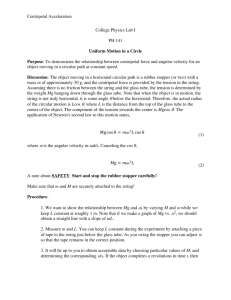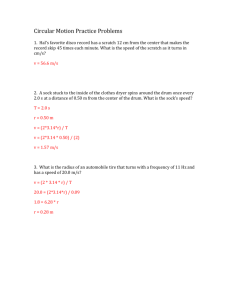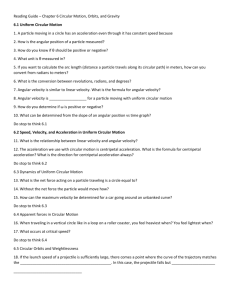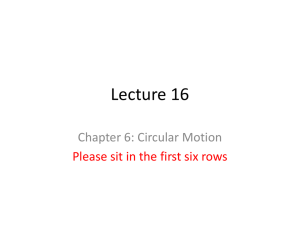M2 Ideas Test - TheChalkface
advertisement
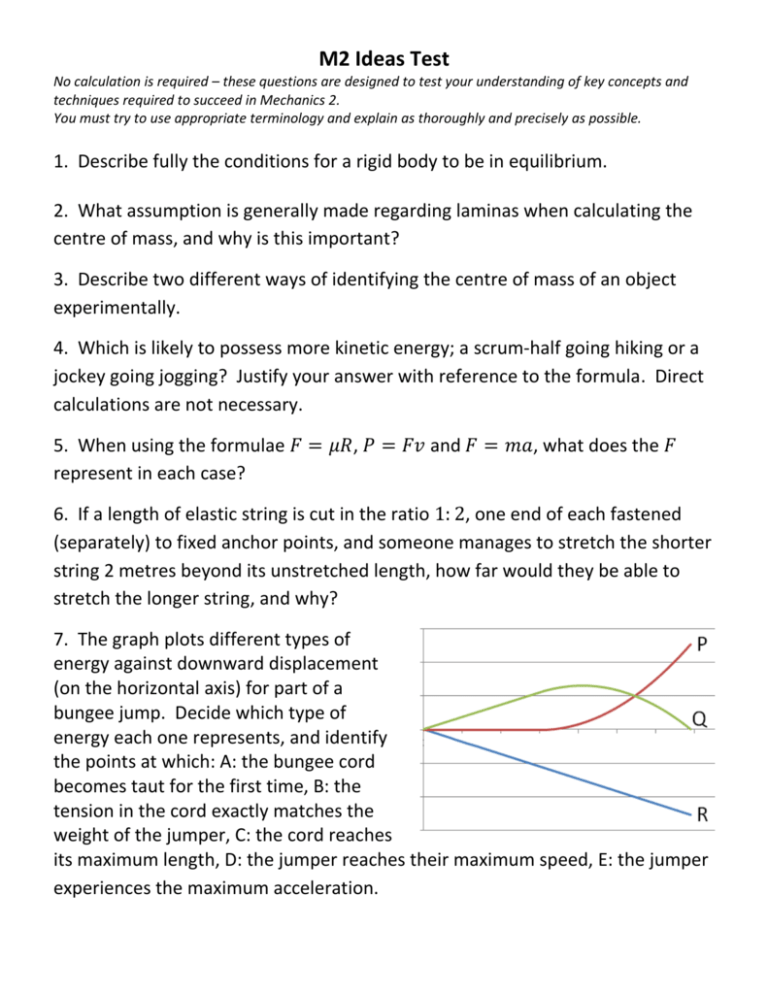
M2 Ideas Test No calculation is required – these questions are designed to test your understanding of key concepts and techniques required to succeed in Mechanics 2. You must try to use appropriate terminology and explain as thoroughly and precisely as possible. 1. Describe fully the conditions for a rigid body to be in equilibrium. 2. What assumption is generally made regarding laminas when calculating the centre of mass, and why is this important? 3. Describe two different ways of identifying the centre of mass of an object experimentally. 4. Which is likely to possess more kinetic energy; a scrum-half going hiking or a jockey going jogging? Justify your answer with reference to the formula. Direct calculations are not necessary. 5. When using the formulae 𝐹 = 𝜇𝑅, 𝑃 = 𝐹𝑣 and 𝐹 = 𝑚𝑎, what does the 𝐹 represent in each case? 6. If a length of elastic string is cut in the ratio 1: 2, one end of each fastened (separately) to fixed anchor points, and someone manages to stretch the shorter string 2 metres beyond its unstretched length, how far would they be able to stretch the longer string, and why? 7. The graph plots different types of energy against downward displacement (on the horizontal axis) for part of a bungee jump. Decide which type of energy each one represents, and identify the points at which: A: the bungee cord becomes taut for the first time, B: the tension in the cord exactly matches the weight of the jumper, C: the cord reaches its maximum length, D: the jumper reaches their maximum speed, E: the jumper experiences the maximum acceleration. 8. How could you find displacement and acceleration from a velocity-time graph? 9. What is the significance of the constant of integration in the context of finding velocity from an expression for acceleration? 10. What are the two different ways of measuring the speed of an object which follows circular motion? Give their names and descriptions. 11. When dealing with horizontal circular motion, which two directions is it generally necessary to resolve forces in, and why? 12. When dealing with vertical circular motion, what are the three main types of circular motion you might encounter, and how do they differ when it comes to the forces acting on the particle? 13. When an object is fixed on a vertical circular track, if it doesn’t have sufficient energy to complete vertical circles, it may oscillate between its highest points. What forces would be acting on the particle, and which way would they point? Note: You should consider both oscillation that goes above the centre and oscillation below the centre. 14. What is the key factor that determines if a particle not fixed in a vertical circular track remains in circular motion? 15. A tennis ball is attached to a string and then given sufficient initial velocity to swing around in a vertical circle from a fixed centre. Which way is the acceleration acting shortly before it reaches its highest point? 16. If the tennis ball is not travelling fast enough to complete full circles, what are the two factors whose combined effect causes the string to go slack? M2 Ideas Test - SOLUTIONS 1. Describe fully the conditions for a rigid body to be in equilibrium. Forces must be balanced (resultant force of zero) and the moment about any given point must be zero. 2. What assumption is generally made regarding laminas when calculating the centre of mass, and why is this important? That the laminas are uniform. That is, their mass is evenly distributed. This means the mass is directly proportional to the area and therefore is not necessary when finding the centre of mass provided the shape and size are known. 3. Describe two different ways of identifying the centre of mass of an object experimentally. Suspending the object from various points – the vertical line will always lie through the centre of mass. Alternatively, spin the object in mid-air and observe the point about which it rotates. 4. Which is likely to possess more kinetic energy; a scrum-half going hiking or a jockey going jogging? Justify your answer with reference to the formula. Direct calculations are not necessary. The jogging jockey. While the rugby player will have a greater mass, the difference in speed will have much more of an effect since the formula shows that kinetic energy is directly proportional to mass, but also directly proportional to the square of the speed. Even though a scrum half is generally one of the lighter players of the team, they are likely to weigh upwards of 80kg while the average jockey will be around 50kg. Taking a hiking speed to be around 4.5mph and a jog at 6mph. This would give the jogger around 10% more kinetic energy. 5. When using the formulae 𝐹 = 𝜇𝑅, 𝑃 = 𝐹𝑣 and 𝐹 = 𝑚𝑎, what does the 𝐹 represent in each case? In 𝑭 = 𝝁𝑹, it represents the maximum frictional force (attained when in motion or in limiting equilibrium). In 𝑷 = 𝑭𝒗 it represents the motive (or driving) force of the vehicle producing the power. In 𝑭 = 𝒎𝒂 it represents the overall resultant force acting on the particle in question. 6. If a length of elastic string is cut in the ratio 1: 2, one end of each fastened (separately) to fixed anchor points, and someone manages to stretch the shorter string 2 metres beyond its unstretched length, how far would they be able to stretch the longer string, and why? 4 metres. Since the force exerted on the two strings would be equal, the tensions in the strings would also be the same. According to Hooke’s law, tension is proportional to the ratio of extension to natural length (the greater the proportion of the extension of the natural length, the greater the tension, for a fixed modulus). Since the two strings are the same material, 𝝀 must be the same for each, so if tension is 𝒙 equal, 𝒍 must be equal. Since the natural length of one is double that of the other, the extension must also be doubled. 7. The graph plots different types of energy against downward displacement (on the horizontal axis) for part of a bungee jump. Decide which type of energy each one represents, and identify the points at which: A: the bungee cord becomes taut for the first time, B: the tension in the cord exactly matches the weight of the jumper, C: the cord reaches its maximum length, D: the jumper reaches their maximum speed, E: the jumper experiences the maximum acceleration. P is elastic potential because it remains at 0 for the first part of the jump (while the cord is slack), then increases at an ever-increasing rate. Q is kinetic since it increases as the jumper accelerates downwards, then decreases as they slow down. R is gravitational potential since it decreases in direct proportion to displacement. A is when EPE stops being 0. B is when the speed is neither increasing nor decreasing, therefore resultant force is zero. C is at the point of maximum extension since kinetic energy has dropped to zero meaning the jumper is now at rest (about to bounce back up). D is maximum speed because kinetic energy is at maximum, and E is maximum acceleration because the force of tension is greatest at maximum extension. 8. How could you find displacement and acceleration from a velocity-time graph? Displacement could be calculated by finding the area under the curve (note that any area below the axis would need to be counted as negative). Acceleration would be given by the gradient of the curve at any given point. 9. What is the significance of the constant of integration in the context of finding velocity from an expression for acceleration? Acceleration only gives information about how the velocity changes. Taking into account a specific value for velocity (eg the initial velocity) allows us to determine the velocity at any point. 10. What are the two different ways of measuring the speed of an object which follows circular motion? Give their names and descriptions. Angular speed, 𝝎, measures the rate at which a particle turns around a circle, given in 𝒓𝒂𝒅 𝒔−𝟏 . Speed, 𝒗, measures the rate at which the particle covers distance, given in 𝒎𝒔−𝟏 . Recall that 𝒗 = 𝒓𝝎. 11. When dealing with horizontal circular motion, which two directions is it generally necessary to resolve forces in, and why? Vertically (at right angles to the plane in which motion is taking place), since these forces will be balanced, and radially (towards the centre of the circle) since this will comprise the centripetal force. 12. When dealing with vertical circular motion, what are the three main types of circular motion you might encounter, and how do they differ when it comes to the forces acting on the particle? Inner circles: object cannot move beyond the circle. Reaction force (or tension in the string if applicable) must always point towards the centre. Outer circles: object cannot fall into the circle. Reaction force must always point directly away from the centre. Fixed circles: object constrained to a circular path, reaction force points radially but can be either towards or directly away from the centre. 13. When an object is fixed on a vertical circular track, if it doesn’t have sufficient energy to complete vertical circles, it may oscillate between its highest points. What forces would be acting on the particle, and which way would they point? Note: You should consider both oscillation that goes above the centre and oscillation below the centre. Weight would act vertically downwards in both cases. For oscillation up to a point above the centre, the normal reaction would point outwards to exactly balance the centripetal component of weight acting inwards. For oscillation below the centre, the normal reaction would point inwards to exactly balance the centripetal component of weight acting outwards. 14. What is the key factor that determines if a particle not fixed in a vertical circular track remains in circular motion? The normal reaction force (or tension) is positive. For inner circles, this means always pointing towards the centre, and for outer circles always pointing directly away. 15. A tennis ball is attached to a string and then given sufficient initial velocity to swing around in a vertical circle from a fixed centre. Which way is the acceleration acting shortly before it reaches its highest point? Angled slightly below the radial line. This is due to the combination of tension (acting directly towards the centre) and weight (acting vertically downwards). This constant changing of the direction of resultant acceleration is what makes vertical circles more complex to deal with, and this is the reason for using energy considerations to determine speed, and from speed, forces, rather than only using forces. 16. If the tennis ball is not travelling fast enough to complete full circles, what are the two factors whose combined effect causes the string to go slack? Since the ball gains gravitational potential as it approaches the top of the circle, it loses kinetic energy and thus the speed drops. This means the required centripetal force for circular motion around a circle with this radius is reduced. In addition to this, towards the top of the circle, an increasingly large portion of the weight is acting inwards in the radial direction (compared to below the centre where the radial component of weight acts away from the centre). This means more of the required centripetal force is provided by weight and less need be provided by tension. If weight on its own is more than the centripetal force requirement, the ball cannot be making complete circles and the string will go slack.

